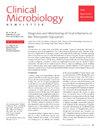基孔肯雅热:阴影中的无声威胁
Q3 Medicine
引用次数: 0
摘要
基孔肯雅病毒(CHIKV)主要与引起严重公共卫生威胁的虫媒病毒有关。基孔肯雅热属甲病毒科和甲病毒属,是引起基孔肯雅热(一种关节炎性疾病)的原因。其显著特征是强烈的关节痛,持续数月甚至数年的易感人群。CHIKF是一种重新出现的疾病,近几十年来在非洲、亚洲和美洲流行,造成全球健康威胁,导致影响数百万人的疫情。CHIKV的发病机制已经研究了50年,但没有证据导致疫苗或药物的开发。目前的管理包括通过支持性护理来缓解症状,以改善患者的生活质量。正在发生的CHIKV疫情表明,迫切需要了解CHIKV的发病机制。了解CHKIV对制定预防和控制疾病传播的措施具有重要意义。本文旨在对其宿主相关因素、媒介相关因素以及病毒遗传学的复杂相互作用等方面进行综述。通过跟踪这些复杂的相互作用,本综述旨在传播有关CHIKV的研究和研究,为这一重新出现的全球健康威胁提供更有效的预防和控制措施的战略。本文章由计算机程序翻译,如有差异,请以英文原文为准。
Chikungunya: The silent threat in the shadows
Chikungunya virus (CHIKV) is mostly related to arboviruses that cause serious public health threats. CHIKV belongs to the family Togaviridae and genus Alphavirus, the cause of chikungunya fever (CHIKF), an arthritogenic disease. Its distinguishing feature is intense arthralgia that lasts for months and even years in susceptible persons. CHIKF is a re-emerging disease that has occurred as an epidemic in Africa across Asia and America in recent decades and has caused global health threats, leading to outbreaks that impact millions of people. Pathogenesis of CHIKV has been researched for >50 years, but no evidence has led to the development of vaccines or drugs. Current management involves reliving symptoms by supportive care to improve the quality of patients’ lives. The ongoing outbreaks of CHIKV show that there is a crying need to understand the pathogenesis of CHIKV. It is important to comprehend CHKIV to develop prevention and control measures for the spread of the disease. This review aims to provide comprehensive knowledge about CHIKV, shedding light on its host-related factors, vector-related factors, and complicated interactions of viral genetics. By following these complex interactions, this review aims to communicate the studies and research about CHIKV, offering strategies that lead to more effective prevention and control measures for this re-emerging global health threat.
求助全文
通过发布文献求助,成功后即可免费获取论文全文。
去求助
来源期刊

Clinical Microbiology Newsletter
Medicine-Infectious Diseases
CiteScore
2.20
自引率
0.00%
发文量
35
审稿时长
53 days
期刊介绍:
Highly respected for its ability to keep pace with advances in this fast moving field, Clinical Microbiology Newsletter has quickly become a “benchmark” for anyone in the lab. Twice a month the newsletter reports on changes that affect your work, ranging from articles on new diagnostic techniques, to surveys of how readers handle blood cultures, to editorials questioning common procedures and suggesting new ones.
 求助内容:
求助内容: 应助结果提醒方式:
应助结果提醒方式:


